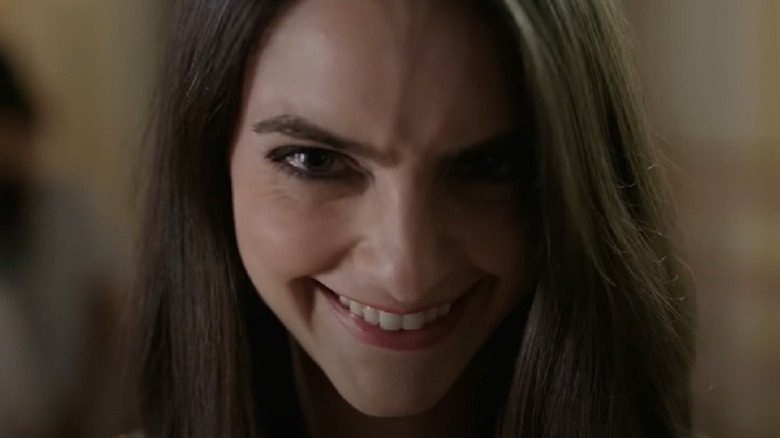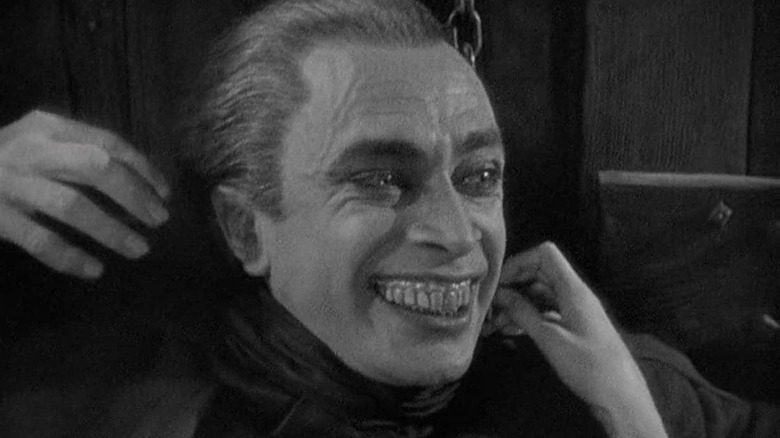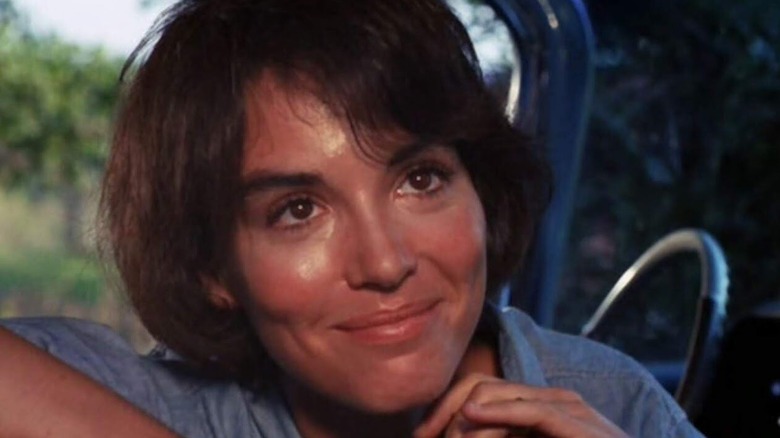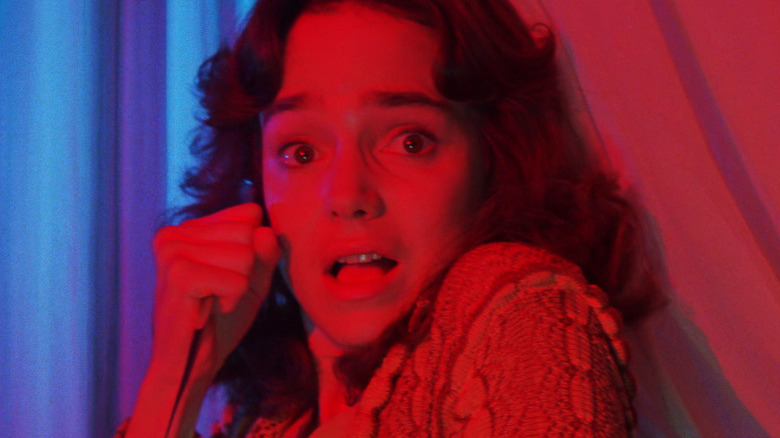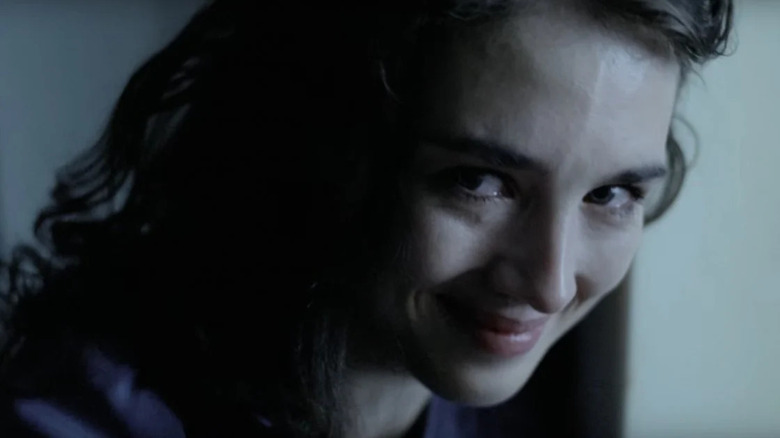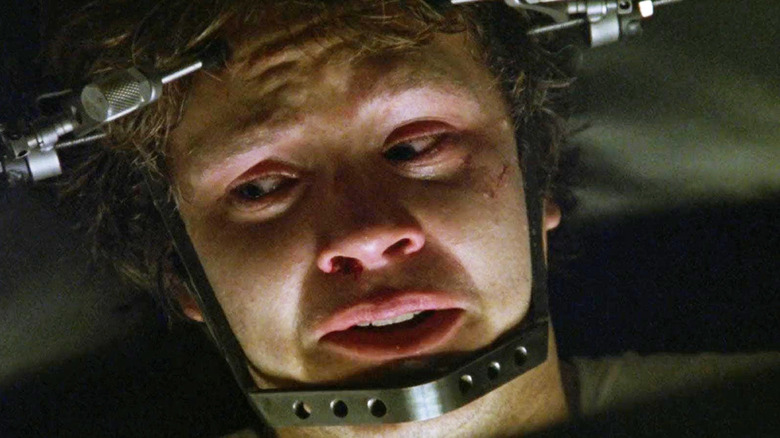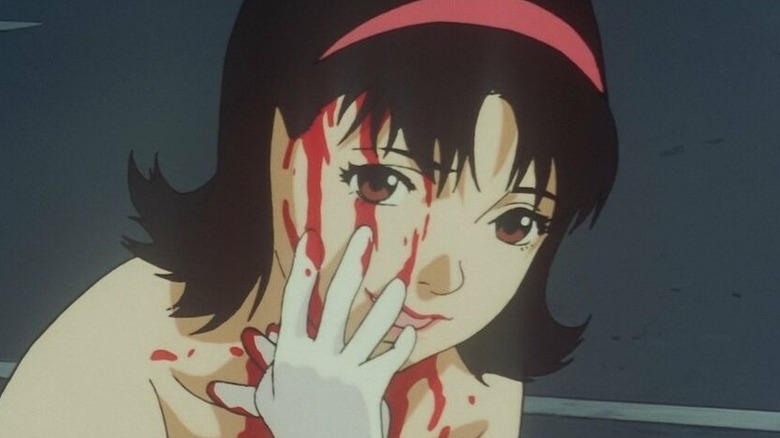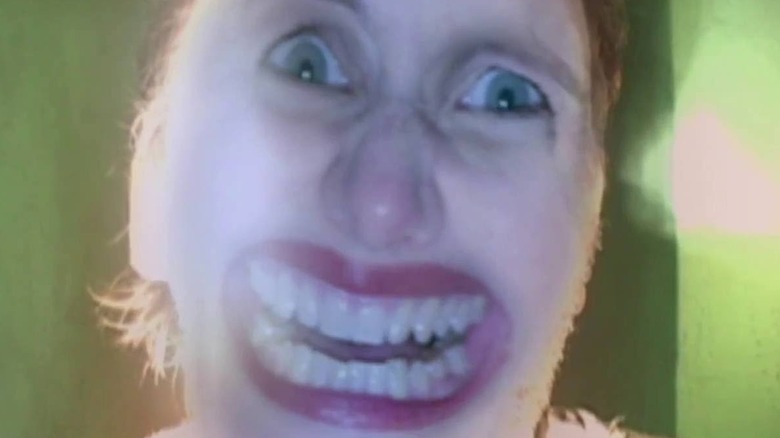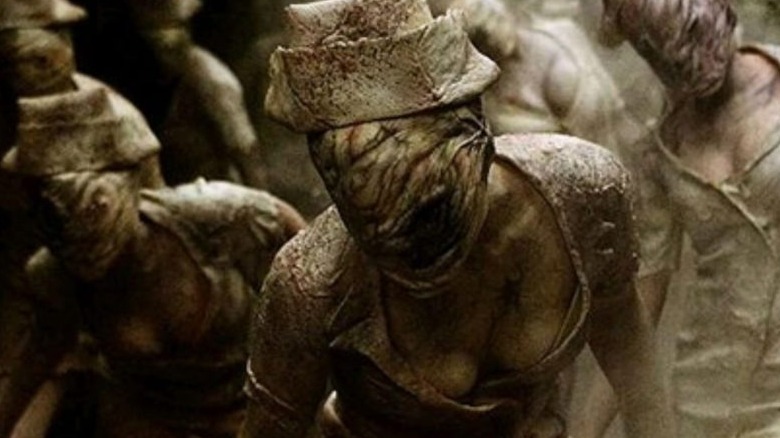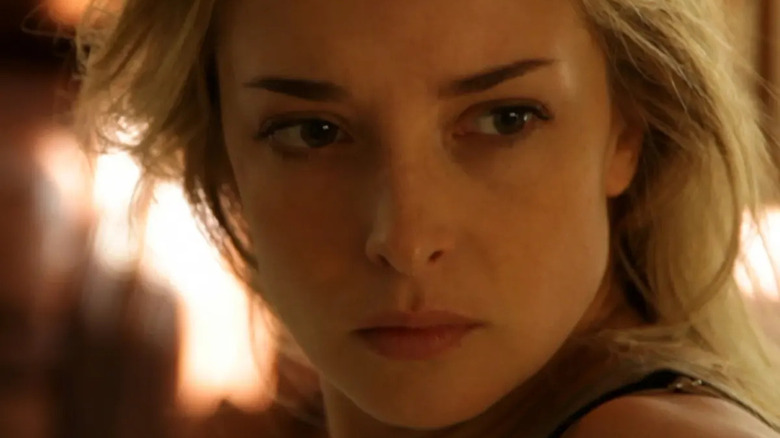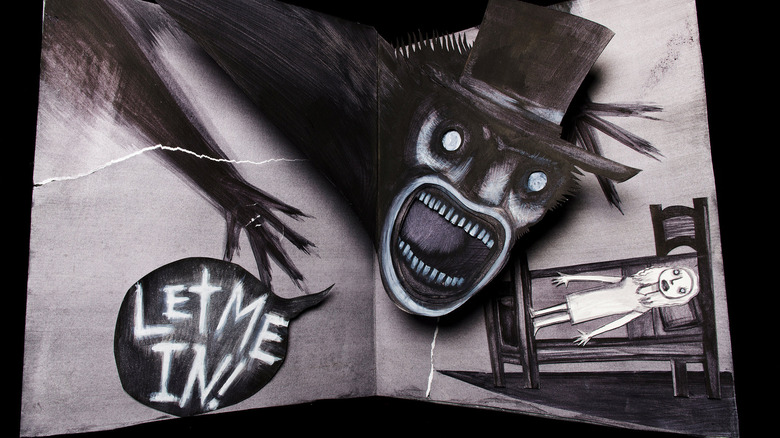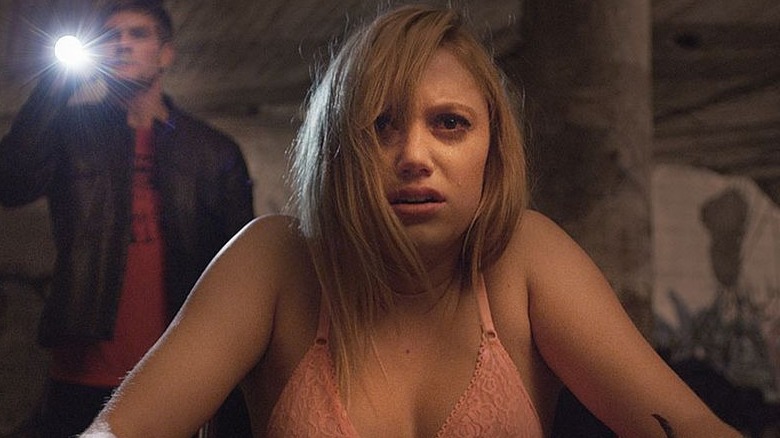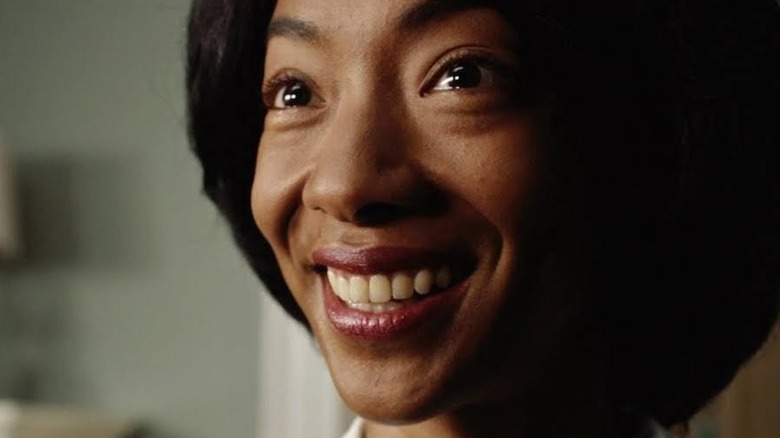12 Best Movies Like Smile You Should Check Out
"Smile" is a 2022 psychological/supernatural horror film directed by Parker Finn in his feature directorial debut and stars Sosie Bacon, Kal Penn, Kyle Gallner, and Jessie T. Usher.
The plot follows psychiatrist Dr. Rose Cotter (Bacon), who witnesses the brutal death of a young college student (Caitlin Stasey) and subsequently begins seeing strange, disturbing images, as well as people spreading the same creepy smile everywhere. Worse, nobody else seems to see these images, and people eventually start to suspect that Rose herself is mentally unstable due to her wild (if true) claims about being stalked by an evil supernatural enemy — especially once she finds out it's connected to a string of deaths dating back decades, and she's also destined to suffer the same fate within the week.
While not a great horror film — some reviews are even calling it "trauma porn" — "Smile" nonetheless has some fun disturbing sequences (if you're into that), some decent and well-executed creature effects, and a great lead performance by Sosie Bacon, who nails the character's admittedly taxing and difficult descent into madness with aplomb as Rose.
If you like what you see with "Smile," there are many other horror films that deal with unseen supernatural terror, characters questioning their reality, and/or unique and disturbing creature designs and are just as good as — if not better than — "Smile." Here's a look at a dozen movies that might fit the bill for your next must-watch feature after "Smile." (Fair warning: Spoilers ahead!)
If you or anyone you know is having suicidal thoughts, please call the National Suicide Prevention Lifeline by dialing 988 or by calling 1-800-273-TALK (8255).
If you or someone you know needs help with mental health, please contact the Crisis Text Line by texting HOME to 741741, call the National Alliance on Mental Illness helpline at 1-800-950-NAMI (6264), or visit the National Institute of Mental Health website.
The Man Who Laughs
"The Man Who Laughs" is a silent gothic epic released in 1928, starring actor Conrad Veidt — best known as Major Strasser from "Casablanca" — as Gwynplaine, the titular "man who laughs." The film is based on the novel of the same name by acclaimed author Victor Hugo (who wrote other classic novels like "The Hunchback of Notre-Dame" and "Les Misérables") and is about a star-crossed romance between the aforementioned disfigured Gwynplaine and the blind and beautiful Dea (Mary Philbin), whom Gwynplaine had saved the life of as a child.
While not a horror film per se, "The Man Who Laughs" does contain a lot of horrific elements (such as the grotesque disfigurement of the protagonist), and other key aesthetic elements of the burgeoning German Expressionist film movement at the time. Furthermore, Gwynplaine, and his horrifying smiling visage, is credited as the inspiration for Batman's arch-nemesis The Joker.
Like 2022's "Smile," there's the obvious motif of smiling in "The Man Who Laughs" and how unsettling a normally jovial facial expression can be twisted and horrifying when constantly sustained inhumanly – especially when done by force (whether supernaturally in "Smile," or by the cruel king in "The Man Who Laughs").
One thing that modern audiences must remember is that silent films were much more intense than they're often given credit for, especially since they existed prior to the film industry's implementation of the Hayes Code, which lasted from 1930-1968 and was a pre-MPA internal regulatory system created by the studios to prevent government regulation. The Hayes Code was seen to be necessary at the time, due in large part due to the supposedly increasing graphic nature of early films.
Let's Scare Jessica to Death
"Let's Scare Jessica to Death" is a 1971 psychological horror film about the titular Jessica (Zohra Lampert), who has just been released from a mental institute after a nervous breakdown. Afterward, her husband Duncan (Barton Heyman) takes her to relax at a remote farm in the woods, alongside his close friend Woody (Kevin O'Connor). However, they all find a beautiful woman already living there named Emily (Mariclare Costello).
Things start to go awry not long after, as Jessica begins seeing strange and nightmarish visions, which she suspects are being prompted by the mysterious Emily. Unfortunately, due to Jessica's recent stay at a mental hospital, she can't bring herself to comment on these visions to her husband, for fear that she'll be sent back. Or, even more horrifying, that she actually is relapsing again.
Like a lot of horror movies of the late '60s and early '70s, such as "Rosemary's Baby" and "The Wicker Man," the pacing of "Let's Scare Jessica to Death" is very deliberate, to say the least. It's also much more interested in maintaining a foreboding atmosphere than it is in visceral jump scares or gore. Furthermore, it's pretty light on plot and is much more about chronicling Jessica's attempts at reintegrating herself into society, as the entire movie is seen through her subjective perspective. However, it's also very engrossing, especially once the unsettling creepiness seeps in more and more.
There are also quite a few similarities between "Let's Scare Jessica to Death" and "Smile." Most notably, both films feature the element of a woman slowly being overcome by mental illness, with no support or help from her peers. In fact, often in both films, these characters only exacerbate Jessica and Rose's problems.
If you or someone you know needs help with mental health, please contact the Crisis Text Line by texting HOME to 741741, call the National Alliance on Mental Illness helpline at 1-800-950-NAMI (6264), or visit the National Institute of Mental Health website.
Suspiria (1977)
"Suspiria" is a surrealist Italian horror film released in 1977, directed by the master of giallo horror himself, Dario Argento. The film follows the demure American ballerina Suzy (Jessica Harper), who joins a prestigious ballerina academy in Germany. However, not everything is as it seems, as many of her classmates are soon found brutally murdered. Worse, she eventually discovers that the entire academy is run by evil witches.
Now, despite Argento's considerable contributions to the vast giallo horror genre, there has been much debate if "Suspiria" actually counts among the giallo canon. Giallo films, for the unfamiliar, are a specific type of Italian horror films that are murder mysteries, which contain dynamic, over-the-top visuals, and inventive, gory kills. And while "Suspiria" contains almost all of those elements, giallo also usually doesn't have overt supernatural elements. Regardless of the pedantic genre specifications, though, "Suspiria" is still nonetheless worth watching. For one, it has amazing cinematography, with overly-saturated and colorful visuals giving it a very unique look, especially within the horror genre. The soundtrack by the rock band Goblin is classic as well.
It also has a lot in common with "Smile," including elements of a woman not being believed for the weird things she witnesses, her trying to evade supernatural threats and curses, and disturbing/dreamlike (and nightmarish) imagery.
There was also a 2018 "Suspiria" remake, directed by Luca Guadagnino and starring Dakota Johnson and Tilda Swinton, and it is worth checking out. However, if you have to choose one, the visual style alone puts the original 1977 version over the top.
Possession
"Possession" is a 1981 horror film by Polish art house director Andrzej Żuławski ("The Devil"), that is almost impossible to cleanly classify. It contains multiple genres — domestic drama, spy thriller, and horror film — and is unflinching in all of them. The story is nominally about the messy deterioration of a marriage between a former spy Mark (Sam Neill) and his erratic wife Anna (Isabelle Adjani), which spirals out into something much more harrowing — and even potentially supernatural — by the end.
Like "Smile," there is a lot of disturbing imagery in "Possession," such as the bloody, skinless, and tentacled creature Anna creates from the body of the victims she's murdered. The two films also share a fluid reality. While the threat in "Smile" is much more overt, with the creature creating false visions in Rose's mind, it is nonetheless stated to be the physical manifestation of trauma, much the way the creature in "Possession" is the physical manifestation of Mark's betrayal, whether real or imagined.
"Smile" and "Possession" also both deal with the concept of possession and doppelgangers. In "Possession," this is connected metaphorically to the Cold War setting, where East/West Berlin (with the film being set in West Berlin) historically separated people and families. In the film, this is symbolized first by the manifestation of "Fate" and "Chance," which inhabit the wife's body at different times throughout the film, as well as the doppelganger Anna created of Mark at the end. In "Smile," the unnamed supernatural entity takes over a victim's body before smiling evilly and ending their lives.
Jacob's Ladder
1990's "Jacob's Ladder" is a cult psychological horror-thriller written by screenwriter Bruce Joel Rubin ("Ghost"), directed by Adrian Lyne ("Flashdance"), and starring Tim Robbins. It is about a Vietnam war vet, the titular Jacob (Robbins), who suffers from horrifying and nightmarish visions and slowly but surely loses grip on reality.
Like Rose in "Smile," the hallucinations Jacob in "Jacob's Ladder" witnesses are gruesome and visceral. This includes Jacob seeing tentacles coming out of a homeless person in a subway station, as well as him witnessing his girlfriend (Elizabeth Pena) being assaulted by a demonic creature on a dance floor, ending with a grotesque protrusion bursting out of her mouth.
There are also the extensive creature effects throughout "Jacob's Ladder," all done practically, which have an unnerving quality about them. The "Smile" creature at the end — before it possesses Rose fully — seems to be influenced, at least in part, by the unique creature designs in "Smile." To be fair, "Jacob's Ladder" seems to have influenced a lot of other horror properties, such as the Japanese video game "Silent Hill," music videos, and it even has a special effect named after it!
Perfect Blue
Satoshi Kon is a world-renowned anime director, with 1997's "Perfect Blue" being his animated feature film debut as a director. However, he is known for many other classic films in the genre such as "Paprika," "Tokyo Godfathers," and the surreal series "Paranoia Agent." Kon has an elastic and inventive animation style, as well as writing twisty and cerebral stories.
"Perfect Blue" follows former Japanese pop star Mami, who leaves her struggling group CHAM! to pursue an acting career on a crime procedural. However, things quickly unravel when she discovers a fan site dedicated to her, that seems to know all her most intimate details. Things get worse when gruesome murders begin happening to people connected to her while being stalked by an obsessive and violent fan. Because of all this, Mimi starts losing grip on reality, to the point that she starts seeing an alter-ego version of herself, dressed in her pink pop star outfit, who taunts and torments her.
There was even some controversy with accusations that acclaimed genre filmmaker Darren Aronofsky had cribbed many story and visual elements from Kon — and "Perfect Blue" in particular — for the Natalie Portman-led psychological thriller "Black Swan." (Kon was previously displeased when "Requiem for a Dream" borrowed from the same film.)
However, beyond that, there are also a lot of similarities between "Perfect Blue" and "Smile" as well. For instance, there's a woman going crazy and losing grip on her reality, creating a world in her head. There are also gruesome murders and disturbing/dreamlike imagery throughout.
Inland Empire
Like a lot of these movies on this list, David Lynch's 2006 nightmarish magnum opus "Inland Empire" is about a woman (in this case, played by Laura Dern) going crazy and losing grip on reality, questioning what is and isn't real.
The movie itself follows actress Nikki Grace (the aforementioned Dern), who begins the story having just landed a role in a film-within-a-film called "On High in Blue Tomorrows." This is contrasted with Dern playing another character from a different reality, named Sue Blue, who is a tough, poverty-stricken woman, escaping a bad marriage. As the film continues, the multiple realities and timelines begin to intersect, inter-cut, and stack on top of each other like Russian dolls. There is also a creepy sitcom shown throughout the film called "Rabbits," where people in bunny costumes — played by Scott Coffey, Laura Elena Harring, and Naomi Watts — talk in nonsense with an accompanying eerie laugh track.
"Inland Empire" actually has a lot in common with "Smile," especially with how Sosie Bacon's Rose experiences her separate reality that not everyone else knows about or is aware of. She starts to lose grip of herself and her sense of place and time, not too dissimilar to Derns' Nikkie and Sue.
There is also the patented disturbing and nightmarish imagery that Lynch employs here, such as the evil Smile creature seen towards the end. Its early digital photography does admittedly take some getting used to at first, but actually adds to the surrealist and dreamlike nature of the movie.
Silent Hill
"Silent Hill," released in 2006, is based on the popular Japanese horror video game series of the same name from developer Konami. It is also one of the best video game movies of all time, which normally isn't saying much, but "Silent Hill" is also a great horror movie period, even without the "for a video game movie" caveat. "Silent Hill" was directed by French filmmaker Christoph Gans ("The City of Lost Children"), who gives the film a great visual flair. And, unlike a lot of video game adaptations, the "Silent Hill" film is very accurate to the games, especially in terms of its setting and creature designs as with the Nurses and Pyramid Head. Even better, the film utilizes practical effects over CGI, making it much less dated than other many video game movies afterward.
"Silent Hill" follows Rose (Radha Mitchell) and Chris (Sean Bean), whose adopted daughter Sharon (Jodelle Ferland) has dreams about the eponymous cursed town of Silent Hill — something Sharon should have no reason to know about — so Rose takes her there to get some answers that might be connected to Sharon's past.
Like "Smile," "Silent Hill" is, ultimately, about trauma and trying to overcome it, as Sharon is a literal physical manifestation of a tortured psychic's trauma (though overcoming it is relatively more successful in "Silent Hill" than in "Smile"). Furthermore, the monster seen at the end of "Smile," especially its skinless final form, also has more than a striking resemblance to some disturbing "Silent Hill" baddies.
Coherence
2013's "Coherence" is a super low-budget, but highly-engaging and thought-provoking, sci-fi drama/thriller. The story follows Emily (Emily Baldoni) as she visits her large group of friends for a dinner party somewhere in Northern California. Tension mounts among the group for a variety of reasons, including Emily and her boyfriend Kevin's (Maury Sterling) relationship being strained due to Emily's indecision in going to the next step in their relationship, compounded by another friend, Amir (Alex Manugian), dating Kevin's ex-girlfriend Laurie (Lauren Maher), who still has feelings for Kevin.
However, after a while, a meteor flies overhead, causing the power to go out. Afterward, everyone starts acting... weird. It is later discovered that the meteorite somehow created a sort-of purgatory where there are only multiple versions of the same NorCal home, as well as different versions of each other running around. Suddenly, different variants are entering different realities, and all chaos breaks loose.
The film itself has a great atmosphere and acting, as well as a very twisty and mind-bending sci-fi plot. The film is almost completely character-driven, with the sci-fi conceit of different versions of each character colliding inside different realities allowing the audience to truly understand the characters more (such as a revelation of a hitherto previously unknown affair between two other friends).
Like "Smile," it's about a woman losing her grip on reality as she tries to understand what is/isn't real and tries to overcome her own issues during the course of the story. The reality of the situation of "Coherence" is admittedly less supernatural than "Smile" — relying on a pseudo-scientific explanation instead — but the character study within a fantastical situation still resonates, regardless.
The Babadook
"The Babadook" was the feature film directorial debut from Australian filmmaker Jennifer Kent, released in 2014. It is a disturbing psychological horror film about a depressed mother named Amelia (Essie Davis), who has a nervous breakdown while trying to single-handedly take care of her special needs child, Sam (Noah Wiseman) after her husband's untimely death.
Eventually, Amelia reads Sam a creepy children's book called "Mister Babadook," where we see the horrifyingly iconic pale-faced, top-hat-wearing creature for the first time as a cardboard pop-up character. Afterward, start to quickly unravel in Amelia's life, as she imagines herself being terrorized by the titular Babadook, and it becomes unclear if it's all in her head or not.
Like "Smile," the creature terrorizing the protagonists is a metaphor for trauma and grief. However, while "Smile" ends (rather problematically) with Rose succumbing to her trauma, "The Babadook" has a much better, more thematically resonant ending/conclusion. In "The Babadook it is revealed that the titular creature can't ever be killed or defeated — only lived with. It is a great way to visually symbolize what it is like to live with a mental illness, in that even if you confront your trauma (as Amelia does when the Babadook forces her to face the death of her husband), it is still something that's a part of you, but it can be controlled and maintain nonetheless.
If you or someone you know needs help with mental health, please contact the Crisis Text Line by texting HOME to 741741, call the National Alliance on Mental Illness helpline at 1-800-950-NAMI (6264), or visit the National Institute of Mental Health website.
It Follows
The critically-acclaimed 2014 supernatural horror film "It Follows" actually shares a lot in common with 2022's "Smile." Both are films about a young woman — in this case, Jamie (Maika Monroe), who is stalked by an inscrutable, unstoppable, and supernatural monster that targets a single victim at a time, which is passed down from person to person.
In "It Follows," the monster is a metaphor for sexually-transmitted diseases, where the creature has sex with the victim to kill them, and then goes down the line to stalk and kill all the people the victim had sex with as well. Meanwhile, in "Smile," the creature is a metaphor for passing on trauma, where the monster forces the victim to die by suicide in front of someone else, eventually leading that person to do the same and perpetuating a viciously never-ending loop.
Furthermore, both films involve the woman's friends not believing them as only she can see monsters. Finally, the monster can take on different forms, and usually someone the main character knows personally.
Of the two, "It Follows" is definitely the stronger film though, as it has a great supporting cast, a killer synth soundtrack from composer Disasterpeace, and a fun production design (such as the anachronistic cute clamshell cellphone).
If you or anyone you know is having suicidal thoughts, please call the National Suicide Prevention Lifeline by dialing 988 or by calling 1-800-273-TALK (8255).
Get Out
Jordan Peele's 2017 socially-conscious horror-comedy "Get Out" is hailed as a modern-day classic — and for good reason. It is a film that critiqued the hidden and heinous hypocrisies lurking within Obama-era white liberals – using progressive language and sound-bite platitudes to uphold what were actually very socially-conservative feelings on race relations and economic inequality.
"Get Out" also relates to "Smile" in many ways. For instance, in both films, the protagonists get stuck inside their own heads, forced to relive trauma for the benefit of an external, malevolent force. In "Get Out," it's the "The Sunken Place" that Daniel Kaluuya's Chris Washington is forced into by Catherine Keener's Dr. Missy Armitage to gain hypnotic control over him, while in "Smile" it's the disturbing hallucinations haunting Sosie Bacon's Rose throughout "Smile" by the evil supernatural entity to feed off her mental pain.
Both films also contain disturbing images involving forced smiles, such as the iconic scene of the Black housekeeper Georgina crying through a smile, as the white grandmother tries to force control over the young Black woman's body she's inhabiting while the real Georgina is obviously in pain over the loss of her bodily autonomy.
